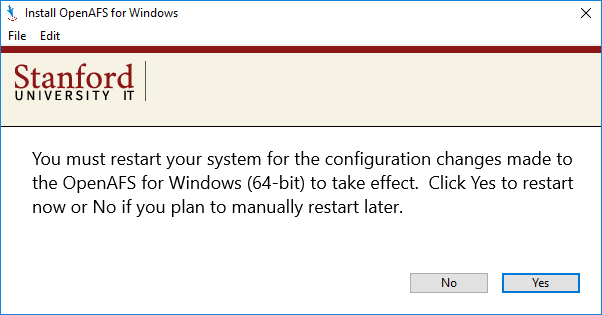Overview
IMPORTANT: You must install Kerberos for Windows prior to installing OpenAFS for Windows.
Stanford OpenAFS for Windows is used to access files that reside on an AFS server. The application includes the OpenAFS client (an open source program ) and the Stanford AFS Controller. The AFS Controller provides Stanford-specific extensions to the OpenAFS client for working with Stanford's network.
An AFS volume is a collection of related files and directories that are grouped together as one unit (for example, your home directory). You can use Stanford OpenAFS to mount AFS volumes in your Windows File Explorer, to use similarly to the way you would work with any other Windows directory. You can create, name, move, copy, select, delete, rename, print and search for AFS files and directories in your File Explorer.
See the Mount AFS Volumes page for instructions on mounting and AFS volume to your desktop.
Installing Stanford OpenAFS
Note: You will be prompted to restart your computer after installing Stanford OpenAFS. Close all open files on your AFS drives before installing OpenAFS. Otherwise, you may loose data that has not been saved.
- Download and run the OpenAFS installer file.
- Click Continue to install OpenAFS for Windows.

- When the installation has completed, you'll need to restart your computer for the configuration changes to take effect. Click Yes to restart your computer now.

- Once OpenAFs is installed and configured, the AFS Controller icon appears in the notification area. Click the icon to launch OpenAFS for Windows.

Using Stanford OpenAFS
- For instructions on how to use Stanford OpenAFS, see Mount AFS Volumes.
- For more information about AFS, see the File and Data Storage: AFS website.
